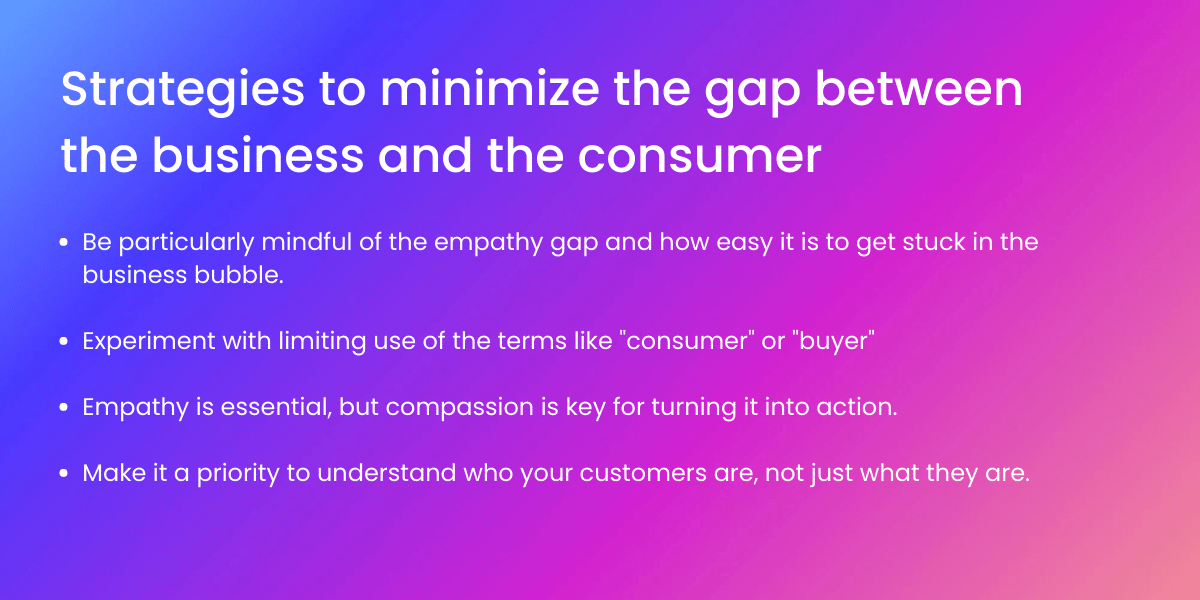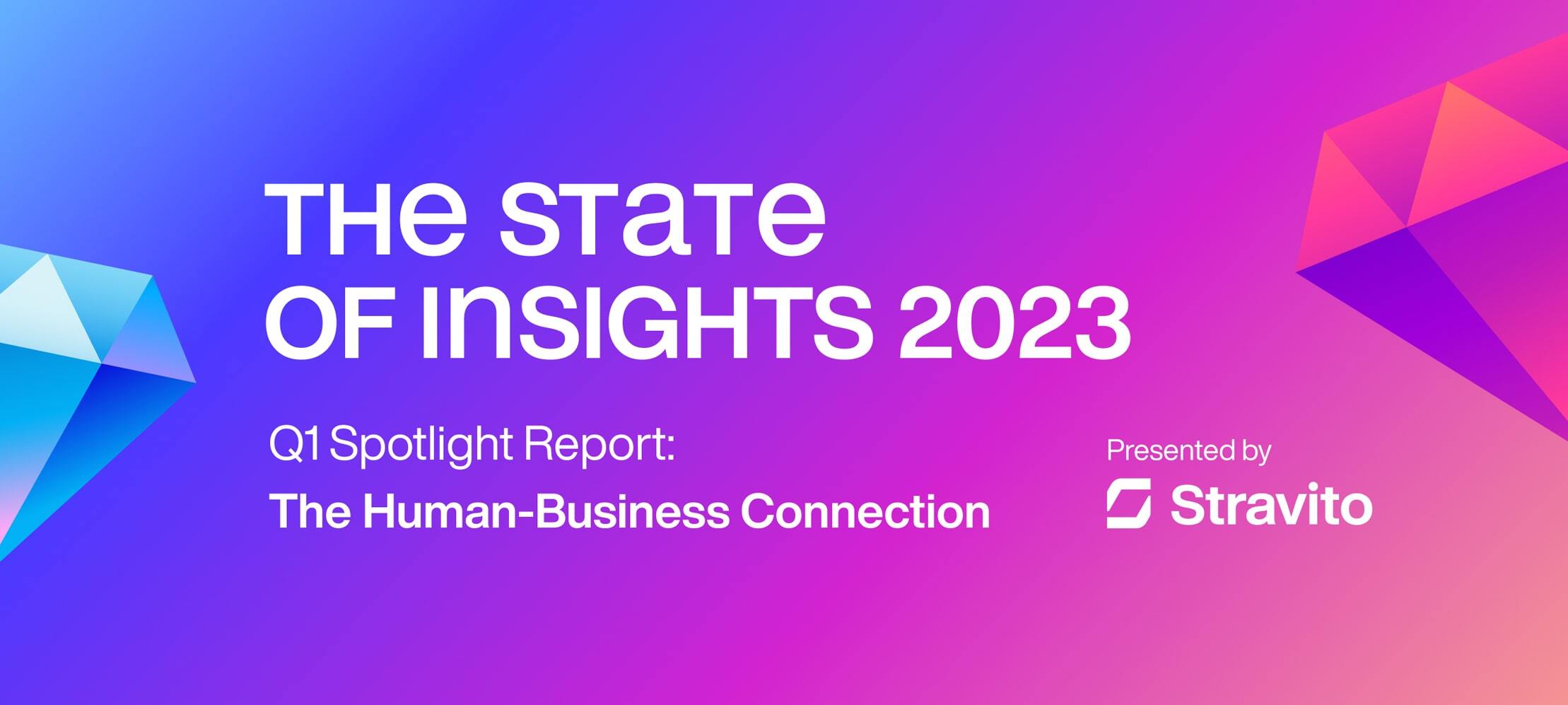The State of Insights 2023 gathered the perspectives of 17 different insights leaders to create an overview of the philosophies, skills, tools, opportunities, and challenges on the minds of industry leaders today.
In this spotlight report, we’re zooming in on our 6 most recent conversations from the Consumer Insights Podcast, focusing on a key theme of the past quarter: the human-business connection.
With the human-business connection, we mean the numerous ways in which humans and business impact each other. Philosophies like consumer centricity and human centricity are mainstays of the insights industry, but the episodes from this quarter show that the business benefits of putting people first have the potential to be even more extensive.
Below, we’ll explore a variety of perspectives on how putting humans first in insights work (and beyond) benefits everyone.
Overview
1. Mind the gap between the business and the consumer
3. Tech is a means to a human-centric end
4. Keep your friends close and your stakeholders closer
5. Tips to strengthen the human-business connection at your organization
1. Mind the gap between the business and the consumer
The notion that businesses can easily fall into the trap of seeing things from an internal perspective isn’t new, but our recent discussions around this challenge offered some fresh angles about what factors contribute to creating that psychological distance.
Closing the empathy gap
Kristof de Wulf, CEO and Co-founder of Human8 (formerly InSites Consulting), highlighted three gaps that can hinder efforts to drive consumer centricity: the empathy gap, the relevance gap, and the experience gap. From his perspective, the empathy gap is often the most challenging to close because it requires helping brand stakeholders to escape their business bubble.
Kristof shared this advice on how to close the empathy gap:
Try to limit using the word “consumer”, I know it's hard, or “buyer". But try to take the bigger perspective of the human perspective. And I know, it's maybe a bit of a hype, or we think it's a hype. We talk a lot about “ human-inspired" instead of “consumer-driven” and so on. But I think it matters.
We are only a tiny slice of the day active as consumers or buyers. The rest of the day we humans are doing other stuff, right? So if the brand doesn't pay attention to that bigger, 360-degree picture, you're losing out on so much opportunity.
Because a brand can be meaningful across a wide variety of use cases, occasions, and help consumers deal with their frictions and problems. So I think, shy away as much as you can from treating people as consumers and buyers.
Kristof’s point highlights how looking beyond the label of consumer can help to create more business opportunity, while also reducing more friction and solving more problems for people in their daily lives.
From empathy to compassion
When asked to share how he creates a thirst for insights, Jorge Calvachi, Director of Insights at La-Z-Boy, reflected on one of their company values: compassion, illustrating a key difference from empathy.
Compassion, it's a little bit higher than empathy because with empathy you actually say, “Well, I'm sorry that this happened to you. I can see that that could be bad or terrible,” but it stops there.
That is when you deliver a report, you're creating empathy. You create compassion when you actually take those insights with a team and then you say, “Okay, we all feel empathy for the consumer, right? So what are we going to do to resolve, to remove that pain point, to create a better consumer experience?”
That is compassion. It's proactive, it is action-driven, and there is a goal.
While business impact isn’t necessarily the first thing that comes to mind when you hear the word compassion, Jorge’s comment demonstrates that it can be used as a way to encourage human-centric impact.
Understand who, not just what
David Allison, Founder of Valuegraphics, a global dataset that uses values-based research to influence and predict the behavior of people anywhere in the world, reminded us of the importance of understanding who people are, not just what they are. In his episode, he explained how values are the primary force driving human decision making, and that they therefore can tell you more about who someone is rather than what they are.
He contrasted this against commonly used demographics, which only really give insight into the latter:
We've been saying that if we know the age and income and gender and marital status and sexual preference of a group of people, we somehow know who they are. And we don't.
We just know what they are. So let's keep using [demographics] that way…they're like the Dewey Decimal System of the insights world.
They say, “This is the bookshelf of people here, this is the shelf of people.” Cool. But assuming that all the books on that shelf are identical to each other, that's a big flaw. And that's what we've been doing wrong.
We've been saying, “Oh great, we know what shelf it's on. So those books, they're all exactly the same. They'll respond to things in the same way.”
David advocates for using valuegraphics, demographics, and psychographics to build a richer picture of your consumers and unlock insights that lead to better business decisions.

2. Ask the right questions
In the State of Insights 2023, we also explored some perspectives on why fighting for a seat at the table and a willingness to ask tough questions are key to creating business impact. This quarter, the focus shifted slightly to the importance of asking not just the tough questions but also the right questions.
The question behind the question
Joanna Dumont, VP of Strategy, Insights, and Innovation at Danone, explained how her team trains on asking power questions, which ultimately lead to more creative solutions. When offering tips on how to ask the right question, her first tip was to question the questions you’re being asked:
First of all, think of the question behind the question. So when somebody comes with a question to you, the conversation starts from there. We never answer directly the initial question. We always are questioning the person who's come to us and asking and discussing to try and get to the root of the problem that they're trying to solve.
This is a prime example of how connection and dialogue with business stakeholders is essential to drive the business forward.
Always ask “Why?”
Elizabeth Oates, VP of Consumer Insights at Ulta Beauty, shared that she sees understanding “the why” as fundamental to insights work. In her episode, she offered an example of how understanding “the why” was crucial for turning around a decline in customer experience numbers:
We found some numbers in our BOPiS (that's our Buy Online, Pickup in Store) channel of sales here. And we found that in this Buy Online, Pickup in Store channel, our experience numbers were starting to slide. And if we were just being interesting, we’d put those numbers on the wall, right?
But we were ready to act. And so we went back and understood “the why” behind those numbers. And we found that there was a bit of a technology issue, but also a communication issue. And so what we found was, to be totally transparent, we hadn't told customers, “We hear you, we know you're here, we're on our way.” And it was really impacting our scores.
But we found the numbers, we found “the why”, and we inspired the business to take action. And as soon as we took action, guess what happened? The scores turned around.
By understanding the human needs behind the numbers, Elizabeth and her team were able to reverse a negative trend and create positive business impact.

3. Tech is a means to a human-centric end
The State of Insights 2023 concluded that, at the end of the day, capabilities will always be more important than tools. Our most recent conversations about the role of tech in insights work continued to refine that picture, illustrating more nuances in the relationship between humans and technology.
Use tech as a tool to connect people with data
Jorge Calvachi (La-Z-Boy) explained that in order to unlock the potential of teams and organizations, the right types of connection are key:
From an insights leadership perspective, we are so focused on connecting data. And there is nothing wrong with connecting secondary data, trends, primary data, qualitative, transactional data. Nothing wrong with it. Perfect, right? I have been doing that all my life.
It is only in the last few years that I realized that what is more important is connecting people with the data. People that have similar questions, similar challenges. So when you connect people with the data, they have something to talk about, and that is where the good conversations happen.
This is where technology can play an important role. Jorge went on to explain how tools that connect people to data facilitate a consumer-centric culture:
I love creating a culture that is consumer-centric. So the tools that help me create that environment where people can access data 24/7, anywhere in the world, identify it in such a way that is easier to digest - some people call it democratizing, socializing data. That is important to me.
Jorge’s perspective highlights how tech can facilitate a deeper understanding of consumers, but also more meaningful conversations with internal stakeholders.
Invest in questions as much as you invest in tech
Joanna Dumont (Danone) explained that her goal is actually make tools invisible and focus on the questions instead, advocating that insights teams should act as an interface between tools and the business:
And it's not that tools aren't important because they are really important, but they're our tools. So I hire a builder to build a house. I don't need to know which hammer he used and which saw he used. What I need to know is that he delivered a house that's stable and sturdy and will stand the test of time. And it's the same for us.
The tools that we have at our disposal now are vastly superior to anything that I could have ever imagined when I started in this industry. And that's wonderful for me because that helps make my life and my team's life that much better.
But it's not about the tools for the audience that I'm communicating with and for my marketing teams and for the business. The business shouldn't care about the tools.
And sometimes that's been a danger in our industry, is that we get fixated on tools when what we really ought to be fixated on is the questions that we ask and leave it to us to answer those questions.
And even with advanced technology like AI, she emphasized the importance of combining human intelligence and artificial intelligence:
For me, it's an enabler to faster, better learning as opposed to a thing in and of itself. And my experience with it so far is that AI is capable of doing, obviously processing massive amounts of data in a much more simple and easy way than what we as human beings were ever capable of doing.
But without human intervention, it's kind of fraught with a lot of challenges and possibly misleading and misguiding. So my experience in some of the projects that we've run was very much it's the combination– it's that unique sort of combination of human intelligence and artificial intelligence that really is where the magic lies.

4. Keep your friends close and your stakeholders closer
We’ve touched on how the right question and tech can facilitate more meaningful stakeholder relationships. Now let’s dig into why stakeholder relationships are so important.
No insights team is an island
Greg Ambrose, former VP of Consumer Marketing at Cineplex, explained how connection is a key tool for insights teams, whether that’s external partnerships with agencies or internal partnerships with other functions. He highlighted how internal connections are essential for business understanding, a backbone of good insights work:
The worst thing I think that can happen to an insights team is to become too insular and sort of be sort of hunkered down and emerge only when they're called…We need to be part of the business.
We are not a standalone team just focused on market research. We need to understand the frontline, the product, the supply chain. We need to understand the opportunity, the future, the financials, so that we understand what matters.
In order to make the right decisions and give the best possible recommendations, it’s essential for the insights function to be integrated into the organization.
Consumer centricity is a team effort
Elizabeth Oates (Ulta) shared how making consumer centricity a reality is all about embedding it throughout the organization:
We have put in our vision to drive consumer centricity throughout our organization. So I want everyone in my organization, not just my team, but everyone, to be thinking about what's right for the guest and making a decision that's right for that guest as well…
And so we really need to have that idea pulsing through, across all aspects of our business, whether it's marketing, or merchandising, or the retail, or the.com, whatever it is. We need to be having that heartbeat really pulsing through.
Without stakeholder buy-in, even the most human-centric insights risk never being implemented.
The underestimated importance of storytelling
Kristof de Wulf (Human8, formerly InSites Consulting) posited that the role of insights professionals is shifting from delivering insights to inspiring with insights. He highlighted the importance of storytelling as a way to help stakeholders connect with insights:
Work harder on not just mastering the art of insights, getting to insights, but really turning around the organization in storytelling and activation. I think it's a big job. I think it's underestimated how important that is.
This is all about making people see and feel things. That's not the same as creating a PowerPoint document and having a one-off workshop. It's about campaigning continuously in a way. And that's a huge transformation.
I think the whole insight industry is preparing for and we are on the journey, but there's a big job there and I think the ones who do this very well will be the leaders of the future for sure.
Emotional resonance isn’t just important when creating external-facing outputs like marketing campaigns or products. It’s also key for ensuring that the insights you share actually stick.

5. Tips to strengthen the human-business connection at your organization
Experiment with language
Be mindful of how frequently you use the terms “consumer” and “buyer”. Experiment with trying to replace that with “person” or “human” and see where it takes you.
Make empathy a habit, but strive for compassion
Empathy is great, but striving for compassion can help you to turn it into action.
Prioritize asking the right questions
Whether you dig into the questions behind the question a stakeholder brings to you or relentlessly return to “the why”, make it a goal to prioritize asking the right questions.
Remember that tech is important, but it’s not the point
See tech as a means to a human-centric end. Whether it’s connecting your stakeholders to consumer insights or helping you to work more efficiently, use it as a way to bring people together and drive business forward.
Continuously connect with stakeholders to drive consumer centricity
Actively work to integrate your team into the rest of the organization and to continuously deepen your understanding of your stakeholders. Building and maintaining meaningful relationships will help you deliver insights in a way that resonates and ultimately keeps the consumer at the heart of all decisions.
Explore these episodes and more
Of course, we couldn't cover all of the wisdom shared in the 200+ minutes of conversation from this quarter's episodes of the Consumer Insights Podcast.
You can find the episodes featured in this episode below, or if you want to explore all episodes of the Consumer Insights Podcast, you can find them on Apple Podcasts, Spotify, and Google Podcasts.
Featured in this report:
- Creating a Consumer-Centric Culture with Jorge Calvachi, Director of Insights at La-Z-Boy
- A Masterclass on Holistic Consumer Insights with Kristof de Wulf, Co-Founder & CEO of Human8 (prev. InSites Consulting)
- Going Beyond Interesting for More Impactful Insights with Elizabeth Oates, VP of Consumer Insights at Ulta Beauty
- The Value of "insights" and "Insights" with Greg Ambrose, former VP of Consumer Marketing at Cineplex
- How Uncovering Values Unlocks Insights with David Allison, Founder of Valuegraphics
- How to Ask Power Questions with Joanna Dumont, VP of Strategy, Insights, and Innovation at Danone




